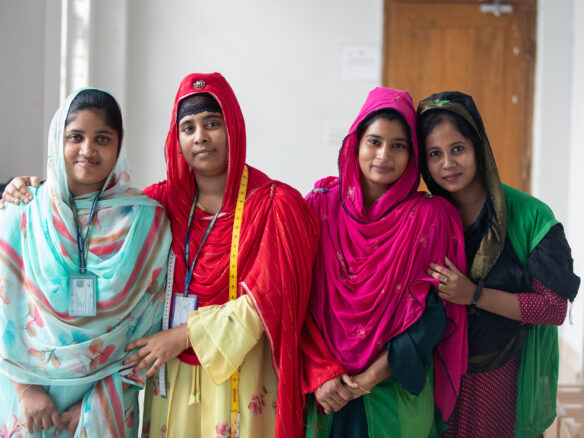
The ready-made-garment (RMG) sector has played a critical role in Bangladesh’s economic development and has long been the backbone of the country’s foreign trade, currently employing nearly 4 million people and contributing 14% to Bangladesh’s GDP. However, this is now under threat. The country´s RMG sector is undergoing a structural transformation alongside a changing global fashion industry. As international apparel brands are starting to move away from their global value chains to more regional production, Bangladesh is at risk of losing competitiveness to other countries that offer greater product diversification and shorter lead times. At the same time, the pace of automation in the RMG sector has been increasing as more factories adopt advanced production technologies, demanding a different setup of skills, technology, and workforce. This development will likely lead to large-scale job losses and women are particularly vulnerable, as they represent the majority of the total workforce within the garment industry and are often employed to execute the routinized tasks which are highly susceptible to automation and are not allocated to leadership positions. The reason for this is two folded; many of them lack the necessary skills and are sometimes illiterate, but there is also the problem of deep-rooted stereotypes saying “women can’t work with advanced technology” or are “not capable for leadership roles”. Consequently, women’s share in the RMG workforce has reduced from 90% in 1980 to 59% in 2020.
“Everybody is talking about the importance of leaving no one behind, but the world seems to have forgotten about the women garment workers. There is an urgent need to create a skilled female workforce to save jobs and create new job opportunities. We’re now calling for action from all stakeholders.”
Charlotte Brunnström, Strategy Lead H&M Foundation
The H&M Foundation is committed to supporting the Bangladeshi RMG industry’s future evolution and is currently running a long-term programme in Dhaka with the primary goal of safeguarding the livelihoods of women garment workers. The H&M Foundation’s aim is to prepare the women garment workers for a future defined by automation and provide them the tools necessary to have greater agency to lead secure, dignified, and fulfilling lives, with enhanced economic opportunities. This is done by breaking traditional gender norms and providing a holistic support, not only by teaching the women digital literacy and soft skills, but also by providing them a sustainable and resilient environment.
Since the underlying factors impacting the women garment workers are uncertain and can change over the next few years, everybody needs to ensure that their actions to improve women’s employability are future-sensitive, both to the changes in the RMG industry globally (and Bangladesh’s place in it), and the changes to women’s participation in the Bangladesh RMG industry.
We are calling on stakeholders to collaborate to safeguard Bangladesh’s women garment workers
Today, critical intervention gaps exist related to creating opportunities for female workers to advance in Bangladesh’s readymade garments industry, preparing them for alternative livelihood opportunities, addressing gender norms, and improving working and living conditions. We are calling on multiple stakeholders, including funders and implementers, to collaborate to safeguard Bangladesh’s women garment workers, and to ensure that future risks are accounted for. Successful collaboration will require stakeholders to work towards a common goal, coordinate their actions, and actively share learnings as they strive towards creating impact. We need to walk away from the silo thinking. Because if we should truly change the unequal power balance, and solve the poverty trap of marginalized people, we need to combine our efforts. Working truly collectively means to give up a little bit of your own control, because in a team you are influenced by each other’s activities, difficulties, and achievements. It also means sharing information and learnings with others.
Most important of all, we need to merge the actual activities on the ground to support the primary actors in a holistic and comprehensive way. We need to assemble all the spread contributions into a “collective whole” and work cross sectoral by bringing in plenty of different stakeholders from different sectors. Complex problems can only be solved by cross-thematic solutions and a multistakeholder approach. To create collective impact, everyone needs to identify synergies between their own organization and the other partners. Hence, it is not just about having the expertise, leadership qualities and networks. It is just as important to have the right mindset and attitude. Like an orchestra, where everyone needs to have that talent – to be able to hear the others – and adapt their own music to create harmony. We invite all organisations working to improve the quality of people’s lives to join us.
Read the reports
These reports have been developed and published by FSG, with support from the H&M Foundation and The Asia Foundation as part of the Collective Impact initiative on Future of Work for Female Garment Workers in Bangladesh.

